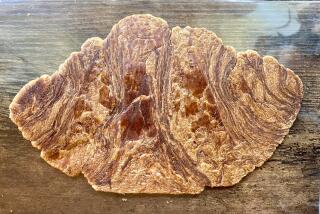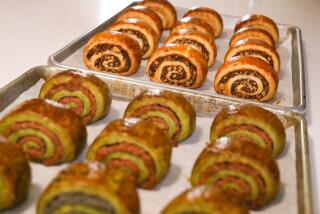Weekend project: Light and airy chiffon cake

Heralded as “the first new cake in 100 years” when it was introduced, the chiffon cake -- one of the darlings of midcentury cuisine -- became famous for its wonderfully light and airy texture, seemingly as weightless as angel food but with a moist tenderness almost like a rich butter cake. The delicate creation was originally developed by a Los Angeles insurance salesman.
Though it may seem like a Betty Crocker-era relic, the cake is as relevant today as it was when it first revolutionized the baking world more than half a century ago. Chiffon is a relatively easy cake to make, lending itself to a host of flavor possibilities and accents. Try a classic orange variation, but complement the flavors a little with rich hazelnuts. Fold cacao nibs into a chocolate cake for extra depth and crunch. Or look to Southeast Asian flavors for inspiration with a fragrant pandan coconut chiffon cake. The options seem endless.
Best of all, the method is simple, requiring a handful of basic ingredients and a few kitchen tools.
The dry ingredients -- flour, sugar, a pinch of salt and a little baking powder -- are sifted together in a large bowl. (Though the egg whites provide most of the lift on this cake, a little chemical leavener helps to seal the deal.) Add the liquids -- oil, egg yolks, a little milk (or water) and flavoring, such as vanilla -- and beat everything together to form a smooth batter.
The egg whites are whipped to form a stiff meringue. To get the most lift from the whites, use room-temperature eggs and be sure to beat them using a very clean bowl and beater -- any traces of dirt or grease can decrease the volume of the meringue.
Beat the whites with a little cream of tartar on low speed to strengthen the structure of the bubbles as they form, then slowly “rain” in the sugar with the mixer going. Keep beating (you can increase the speed of the mixer) just until the whites form “stiff peaks” when the beater is lifted. Check the eggs as they thicken; if the eggs overbeat (they will look crumbly), their delicate structure will break down and won’t be able to support and lift the cake as it bakes.
Gently fold the eggs into the batter before transferring it to the pan. As the cake bakes, it literally puffs up in the oven and can rise over the top of the pan by a few inches. It’s done when the cake is golden and springs back gently when touched.
Immediately invert the cake over a wine or tall soda bottle as soon as it’s out of the oven. This gives the proteins in the cake time to set up as it cools, so the delicate structure doesn’t collapse under its own weight.
Because of that light structure, chiffon cakes work best lightly garnished. Don’t weigh the cake down with a heavy frosting. Dust the cake with powdered sugar, maybe a little sweetened cocoa powder. Or leave the cake alone, sliced thin and served with a dollop of freshly whipped cream and fresh berries.
Check out the recipe below for a basic chiffon cake, or try out our recipe for chocolate chiffon or pandan chiffon with coconut icing. And feel free to experiment with flavorings and additions.
Cooking is fun – at least it should be! No matter how long you’ve been in the kitchen, there is always something new to learn, whether it’s a simple twist on an old technique, or a handy tip to save time and energy. In this series of short videos, I demonstrate a variety of kitchen tips, ranging from how to hold a chef’s knife for maximum control to using a spoon to peel fresh ginger. If you have any gadgets, kitchen tips or questions you’d like me to explore, leave a comment below or shoot me an email at noelle.carter@latimes.com.
CHIFFON CAKE
Total time: 1 1/2 hours plus cooling time for the cake
Servings: 12 to 16
Note: This recipe calls for a 10-inch angel food cake pan (preferably a pan with a removable insert).
2 cups (8 ounces) cake flour
1 1/2 cups sugar, divided
2 1/2 teaspoons baking powder
3/4 teaspoon salt
7 eggs separated, plus 2 egg whites
1/2 cup vegetable oil
3/4 cup milk
1 teaspoon vanilla extract
3/4 teaspoon cream of tartar
1. Heat the oven to 325 degrees.
2. In a large bowl, sift together the cake flour, 1 1/4 cups sugar, baking powder and salt. Whisk the dry ingredients well to make sure they are thoroughly combined. Make a well in the center of the dry ingredients.
3. In a small bowl, beat the egg yolks. Pour the egg yolks into the well, along with the vegetable oil, milk and vanilla. Beat the wet ingredients into the dry until completely smooth.
4. In the bowl of a stand mixer or in a large bowl using a hand mixer, beat the egg whites and cream of tartar until foamy. With the mixer running, slowly rain in the remaining one-fourth cup sugar. Continue to beat the whites until stiff peaks form when the beater is lifted.
5. Fold the beaten whites into the rest of the batter: Gently spoon one-third of the beaten egg whites into the large bowl with the batter. Slowly and carefully fold the whites into the batter using a spatula or whisk until mixed. Add another third of the beaten whites to the bowl and gently fold into the batter. Be very gentle as you fold in the whites as you do not want to deflate them; the whites lighten the batter and are largely responsible for the cake’s ability to rise as it bakes. Gently fold in the remaining third of the whites.
6. Spoon or gently pour the batter into a 10-inch ungreased angel food cake pan. Place the pan in the oven and bake until the cake is puffed (it should rise over the top of the pan by 2 to 3 inches but will deflate a little as it cools), lightly browned on top and a toothpick or cake tester inserted comes out clean, 1 hour to 1 hour and 10 minutes.
7. Remove from heat and invert the pan over a wine or soda bottle. Set the pan aside in a quiet place until cooled completely, 1 to 2 hours.
8. Loosen the sides with a thin knife or metal spatula and tap it gently to remove the cake (if using a two-piece pan, loosen the outside of the pan to remove, then gently work the knife or spatula along the top of the insert and inside to remove the cake) before serving.
Nutrition information: Each of 16 servings: 228 calories; 5 grams protein; 31 grams carbohydrates; 0 fiber; 9 grams fat; 1 gram saturated fat; 83 mg cholesterol; 20 grams sugar; 229 mg sodium.
Love cooking as much as I do? Follow me @noellecarter
More to Read
Eat your way across L.A.
Get our weekly Tasting Notes newsletter for reviews, news and more.
You may occasionally receive promotional content from the Los Angeles Times.







